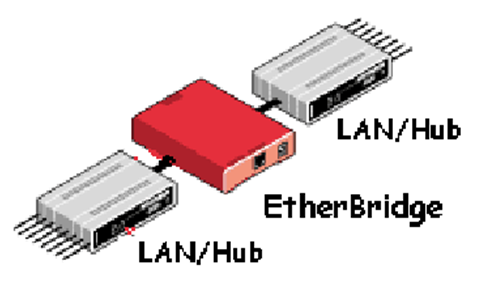The most obvious difference is that hubs operate at Layer 1 of the OSI model while bridges and switches work with MAC addresses at Layer 2 of the OSI model.
Hubs are really just multi-port repeaters. They ignore the content of an Ethernet frame and simply resend every frame they receive out every interface on the hub. The challenge is that the Ethernet frames will show up at every device attached to a hub instead of just the intended destination (a security gap), and inbound frames often collide with outbound frames (a performance issue).
In the physical world a bridge connects roads on separate sides of a river or railroad tracks. In the technical world, bridges connect two physical network segments. Each network bridge kept track of the MAC addresses on the network attached to each of its interfaces. When network traffic arrived at the bridge and its target address was local to that side of the bridge, the bridge filtered that Ethernet frame so it stayed on the local side of the bridge only.
If the bridge was unable to find the target address on the side that received the traffic, it forwarded the frame across the bridge hoping the destination will be on the other network segment. At times there were multiple bridges to cross to get to the destination system.
The big challenge is that broadcast and multicast traffic have to be forwarded across each bridge so every device has an opportunity to read those messages. If the network manager builds redundant circuits, it often results in a flood of broadcast or multicast traffic, preventing unicast traffic flow.
Switches use the best of hubs and bridges while adding more abilities. They use the multi-port ability of the hub with the filtering of a bridge, allowing only the destination to see the unicast traffic. Switches allow redundant links and, thanks to Spanning Tree Protocol (STP) developed for bridges, broadcasts and multicasts run without causing storms.
Switches keep track of the MAC addresses in each interface so they can rapidly send the traffic only to the frame’s destination. The other benefits of using switches are:
- Switches are plug-and-play devices. They begin learning the interface or port to reach the desired address as soon as the first packet arrives.
- Switches improve security by sending traffic only to the addressed device.
- Switches provide an easy way to connect segments that run at different speeds, such as 10 Mbps, 100 Mbps, 1 Gigabit, and 10 Gigabit networks.
- Switches use special chips to make their decisions in hardware making low processing delays and faster performance.
- Switches are replacing routers inside networks because they are more than 10 times faster at forwarding frames on Ethernet networks.
Related Posts
Standard Layers
What is This Thing Called a Network
Related Courses
Networking & Wireless Training


 Worldwide Locations
Worldwide Locations


